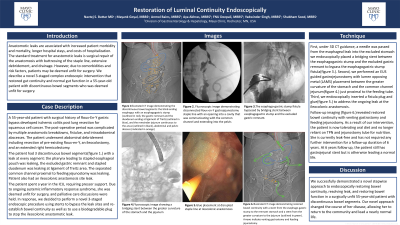Tuesday Poster Session
Category: Endoscopy Video Forum
P3224 - Endoscopic Restoration of Luminal Continuity

- NB
Navtej Buttar, MD
Mayo Clinic
Rochester, Minnesota
Presenting Author(s)
1Mayo Clinic, Rochester, MN; 2John A. Burns School of Medicine, University of Hawaii, Honolulu, HI; 3NYU Langone Health, New York, NY
Introduction:
Anastomotic leaks are associated with increased morbidity, mortality, and healthcare burden. The standard care for these is surgical repair of the anastomosis with buttressing of the staple line, extensive debridement, and drainage. We describe a novel 3-staged complex endoscopic intervention that restored gut continuity and gut function in a 55-year-old patient who was unfit for surgery.
Case Description/Methods:
A 55-year-old female with surgical history of Roux-En-Y gastric bypass developed ischemic colitis post lung resection for squamous cell cancer. The post-operative period was complicated by multiple anastomotic breakdowns, fistulae, and intrabdominal abscesses. She underwent abdominal debridement including resection of pre-existing Roux-en-Y, an ileocolostomy, and an extended right hemicolectomy.
She had 3 discontinuous bowel segments with a leak at every segment: the pharynx leading to stapled esophageal pouch was leaking, the excluded gastric remnant and stapled duodenum was leaking at ligament of Treitz area. The separated common channel proximal to feeding jejunostomy was leaking along with an ileocolonic anastomosis site leak.
Due to ongoing systemic inflammatory response syndrome, she was unfit for surgery, and palliative care discussions were held. We decided to perform a novel 3-staged endoscopic procedure using stents to bypass the leak sites and re-establish bowel continuity as well as to use a biodegradable plug to stop the ileocolonic anastomotic leak.
First, under 3D CT guidance, a needle was passed from the esophageal leak into the excluded stomach, we endoscopically placed a bridging stent between the esophagogastric stump and the excluded gastric remnant to bypass the esophagogastric stump fistula. Second, we performed an EUS guided gastrojejunostomy with LAMS (Lumen Apposing Metal Stents) placement between the greater curvature of the stomach and the common channel jejunum just proximal to the feeding tube. Third, we endoscopically inserted a fistula plug and glue to address the ongoing leak at the ileocolonic anastomosis.
Follow-up imaging revealed restored bowel continuity with venting gastrostomy and feeding jejunostomy. Post procedure she is tolerating oral diet and is off TPN and jejunostomy tube. She has been leak-free for a follow-up duration of 6 years.
Discussion:
We successfully demonstrated a novel stepwise approach to endoscopically restoring bowel continuity that changed the course of her disease, allowing her to lead a near normal life.
Disclosures:
Navtej S. Buttar, MD1, Anmol Bains, MBBS1, Mayank Goyal, MBBS1, Aya Akhras, MBBS1, Yadwinder Singh, MBBS1, Shubham Sood, MBBS1, Fnu Chesta, MD2, Meher Oberoi, MBBS3, Fnu Deepali, MBBS1. P3224 - Endoscopic Restoration of Luminal Continuity, ACG 2023 Annual Scientific Meeting Abstracts. Vancouver, BC, Canada: American College of Gastroenterology.
